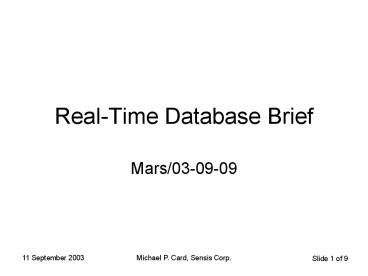11 September 2003 - PowerPoint PPT Presentation
1 / 9
Title:
11 September 2003
Description:
Software lead for Lockheed Martin's RODEO (Real-Time Object Database with ... standards that led to the FIRM/RODEO team's participation in ODMG. Slide 8 of 9 ... – PowerPoint PPT presentation
Number of Views:77
Avg rating:3.0/5.0
Title: 11 September 2003
1
Real-Time Database Brief
- Mars/03-09-09
2
Some of the RT DB folks
- Mayford Roark Inventor of CODASYL-based Real
Time Data Manager (RTDM) CSCI for Seawolf
submarine combat system, author of SRS for
Functionally Integrated Resource Manager (FIRM)
real-time object-oriented database manager.
Represented Lockheed Martin on US Navy NGCR DISWG
standards body, published authoritative paper on
object-oriented real-time data management for
1996 Software Technology Conference. - Steve Ruberg Former employee of Air Force
Research Laboratory (AFRL) Wright Laboratory who
envisioned FIRM and guided the FIRM RFP and its
AFRL requirements - Mike Card (me) Member of Mayfords RTDM
development team, software lead for FIRM program.
Represented Lockheed Martin as voting member of
the now defunct Object Data Management Group
(ODMG) and as member of ECMA Technical Committee
40 for Ada95 object database bindings to ODMG
object model (with extensions to support
real-time DB). Software lead for Lockheed
Martins RODEO (Real-Time Object Database with
Extensions to ODMG), successor to FIRM program. - Paul Springer Real-time database application
developer for Seawolf program, member of FIRM and
RODEO software development teams. Developed
multithreaded socket server for FIRM/RODEO and
designed RODEO replication mechanism. Application
software development lead for Advanced Integrated
Electronic Warfare System (AIEWS), which used
RODEO as track file manager and for emitter
classification, both very demanding firm
real-time applications
3
Real-time DB timeline
RTDM
EagleSpeed-RTDB
FIRM
RODEO
OMG?
ODMG-Ada95
NGCR DISWG
8/2001
9/2003
8/1991
4/1/1993
9/1995
8/1998
11/1996
11/1998
NGCR DISWG US Navys Next Generation Computer
Resources Database
Interface Standards Working Group
4
Why did this stuff ever start?
- 1987 - AN/BSY-2 Combat Sonar Systems
Requirement - The Database Manager shall provide relational or
equivalent access as well as - direct access to underlying tables
(3.2.1.2.3.2.1)2. - Selected COTS DBMS product and ran benchmarks
only to find that - Performance didnt meet real-time
requirements. - Execution times were unpredictable.
- DB Administration was required every 24 hours
for storage defragmentations and garbage
collection - DBMS did not guarantee contiguous storage on
disk, resulting in slower data access. - Type conversion from Ada to DBMS and vice
versa resulted in additional complexity and
development costs. - After exhaustive attempts to utilize a COTS DBMS,
the decision was made to - design, build and field our own Real-Time DBMS
for the AN/BSY-2 Combat System.
5
Conventional vs. real-time DB
6
Essential RT DB Features
- Largely fragmentation free, supporting
long-term unattended - operation.
- Minimizes Interprocess Communication.
- Uses appropriate Data Model.
- Utilizes unique data structures.
- Uses Main Memory.
- Contains efficient Concurrency Control
mechanism. - Provides fault-tolerance.
- Worst-case performance times can be predicted
at design time - Real-time characteristics must designed into the
architecture of - the DBMS they can not be added onto an existing
DBMS.
7
Data Model
- The network (CODASYL, Conference On DAta SYstems
and Languages) - and object (ODMG) data models were excellent for
use in real-time - embedded systems because they allowed the
application developer to - control the navigation path for accessing the
data, thus making determinism - possible.
- In addition to providing control of the data
navigation path, the object data - model also allowed more seamless integration of
the programming - languages type system with the database engine.
This was a double - boost for real-time application developer
productivity. - It was our recognition of these benefits and
AFRLs desire to support - standards that led to the FIRM/RODEO teams
participation in ODMG.
8
Real-time DB Benefits
- Unlike traditional home-brewed approaches to
this problem based on - user-defined data structures, mutexes and
messages, a real-time database - engine offers a common data management solution
that provides fast - data structures and key lookups, transaction
semantics, fault-tolerance, - persistence and replication.
- A custom-brewed solution might run faster, but
a real-time database - solution will be faster to build and get
working. It will also make it easier - for programmers to work in different areas of a
large, complex project. It - will allow the application developers to focus on
the application, not on - managing the data.
9
What was actually developed?
- Do excerpts from RTAG brief(s) and
- STC presentations if there is time /
- if desired





![(READ)^ We Look (Dick and Jane) Paperback – September 15 2003 [PDF EPuB AudioBook Ebook] PowerPoint PPT Presentation](https://s3.amazonaws.com/images.powershow.com/10149758.th0.jpg?_=20241005097)

























